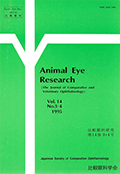Volume 14, Issue 3-4
Displaying 1-14 of 14 articles from this issue
- |<
- <
- 1
- >
- >|
Reports of the Symposium on Problems in Animal Ophthalmologic Examination at the 14th Annual Meeting
-
1995Volume 14Issue 3-4 Pages 3-4_105-3-4_113
Published: 1995
Released on J-STAGE: December 25, 2020
Download PDF (2821K) -
1995Volume 14Issue 3-4 Pages 3-4_115-3-4_124
Published: 1995
Released on J-STAGE: December 25, 2020
Download PDF (2916K)
Workshop of the 14th Annual Meeting of the Society
-
1995Volume 14Issue 3-4 Pages 3-4_125-3-4_126
Published: 1995
Released on J-STAGE: December 25, 2020
Download PDF (421K) -
1995Volume 14Issue 3-4 Pages 3-4_127-3-4_128
Published: 1995
Released on J-STAGE: December 25, 2020
Download PDF (519K) -
1995Volume 14Issue 3-4 Pages 3-4_129-3-4_133
Published: 1995
Released on J-STAGE: December 25, 2020
Download PDF (1316K) -
1995Volume 14Issue 3-4 Pages 3-4_135-3-4_139
Published: 1995
Released on J-STAGE: December 25, 2020
Download PDF (1275K) -
1995Volume 14Issue 3-4 Pages 3-4_141-3-4_149
Published: 1995
Released on J-STAGE: December 25, 2020
Download PDF (2621K) -
1995Volume 14Issue 3-4 Pages 3-4_151-3-4_159
Published: 1995
Released on J-STAGE: December 25, 2020
Download PDF (2409K) -
1995Volume 14Issue 3-4 Pages 3-4_161-3-4_168
Published: 1995
Released on J-STAGE: December 25, 2020
Download PDF (2077K)
Original Reports
-
1995Volume 14Issue 3-4 Pages 3-4_169-3-4_173
Published: 1995
Released on J-STAGE: December 25, 2020
Download PDF (1342K) -
1995Volume 14Issue 3-4 Pages 3-4_175-3-4_178
Published: 1995
Released on J-STAGE: December 25, 2020
Download PDF (1265K)
Information & Data
-
1995Volume 14Issue 3-4 Pages 3-4_179-3-4_182
Published: 1995
Released on J-STAGE: December 25, 2020
Download PDF (1231K) -
1995Volume 14Issue 3-4 Pages 3-4_183-3-4_191
Published: 1995
Released on J-STAGE: December 25, 2020
Download PDF (2189K) -
1995Volume 14Issue 3-4 Pages 3-4_193-3-4_197
Published: 1995
Released on J-STAGE: December 25, 2020
Download PDF (1522K)
- |<
- <
- 1
- >
- >|
